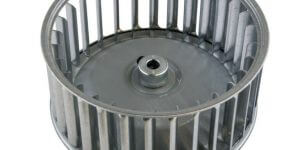A centrifugal fan (often referred to as a coop fan) may be a machine used for moving air or different gases because of their straightforward style, centrifugal fans area unit factory-made easier than different kinds of fans that saves time and prices. This makes them a well-liked alternative for air handling applications.
Through their rotating impellers, with either forward- or backward-curved blades, centrifugal fans increase the speed & the volume of an air stream and have superior mechanical properties compared to axial fans, as an example.
Energy potency (reaching up to eighty-four static potency), sturdiness even in corrosive environments, simple maintenance, and suitableness for multiple airflow/pressure combos area units the most blessings that engineers take into account once selecting them for HVAC applications.[1]
How to Predict a Centrifugal Fan’s mechanics Efficiency?
As mentioned higher than, its mechanics is one of every of the simplest blessings of a centrifugal fan. This is often why throughout the planning method, it’s necessary to build to form to create} positive that style engineers make the foremost out of its properties to maximize potency. This is often once procedure fluid dynamics (CFD) simulations acquire play.
CFD is that the technique used for the computerized calculation of fan mechanics quality to accurately predict its performance early within the style stage, analyze numerous CAD models, scale back the quantity of physical prototypes and overpriced testing and optimize the planning for optimum performance.
Sim Scale’s CFD resolution permits fan designers to calculate flow rates, static pressure, total pressure, static efficiency, total potency, peak total potency, forces and moments working on the fans and a lot of, 100% within the browser, giving flexibility, collaboration choices and access to high computing power — up to thirty-two cores —from a standard computer or laptop computer.
CFD Analysis of a Centrifugal Fan style
An example is that this CFD analysis, which was performed on the planning of a centrifugal radial compact fan with a forward-curved vane. this sort of fans area unit is used for natural philosophy cooling applications like thermal management for the picture show, IT, and medium systems.
The goal for the 3D simulation was to predict the fan’s mechanics performance and establish areas for style optimization.
The contours below show a 3D visualization of static pressure, flow rate, and also the mechanic’s forces working on the rotor. The performance curves obtained from this analysis area, unit key indicators for deciding whether or not the planning meets the wants or desires optimization.

